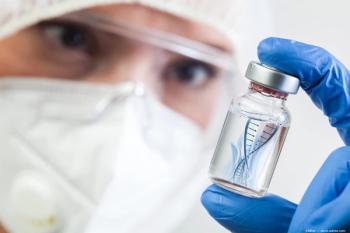
- Ophthalmology Times: September 15, 2020
- Volume 45
- Issue 15
Targeting AMD patient treatment burden
Intravitreal gene therapy continues to be well tolerated and shows robust efficacy
This article was reviewed by Charles Wykoff, MD, PhD
The results achieved with intravitreally injected gene therapy for neovascular
ADVM-022 may help solve the significant treatment burden associated with the treatment of neovascular AMD that includes frequent trips by patients to undergo intravitreal injections of various anti-vascular endothelial growth factor (VEGF) agents.
“Perhaps most important is the finding that the frequency needed to achieve optimal outcomes is often not realized in the real world,” noted Charles Wykoff, MD, PhD, who is in private practice in Houston, Texas.
Related:
This adeno-associated virus (AAV) gene therapy vector comprises an AAV7m8 capsid, a promoter to achieve protein expression, and a codon-optimized cDNA to drive aflibercept (Eylea, Regeneron Pharmaceuticals) that is delivered to the intravitreal space.
Two preclinical studies have demonstrated the long-term protein expression in nonhuman primates that extended up to 21 and 30 months after 1 intravitreal injection.
Wykoff suggested that 1 solution to this undertreatment is the establishment of an intraocular biofactory that produces an anti-VEGF agent using gene therapy to deliver long-term efficacy, which is what ADVM-022 was designed to do.
Related:
Results
Wykoff reported the updated 24-week results on behalf of the OPTIC investigators. OPTIC (NCT03748784) is a phase 1, 2-year multicenter dose-ranging study of ADVM-022 in neovascular AMD with the primary assessment of safety and tolerability of 1 intravitreal injection.
Patients in cohorts 1 and 2 received oral steroid prophylaxis to prevent ocular inflammation and respective doses of ADVM-022 of 6 x 1011 vg/eye and 2 x 1011 vg/eye.
Patients in cohorts 3 and 4 received a topical steroid for prophylaxis; cohorts 3 and 4 were treated with doses of ADVM-022 of 2 x 1011 vg/eye and 6 x 1011 vg/eye. Patients could receive rescue therapy, if needed.
The durations of the follow-up periods differed among cohorts: 6 patients in cohort 1 were followed for a median of 60 weeks, 6 patients in cohort 2 a median of 36 weeks, and cohort 3 a median of 20 weeks.
The current evaluation, which extended to April 1, 2020, showed no serious safety issues at 24 weeks. Low-grade inflammation associated with treatment was seen often and responded to topical steroids. The patients in cohort 3 had fewer adverse events compared with the others, he noted.
Related:
The inflammatory events in the 6 patients in cohorts 1 and 2 were low grade and responsive to oral steroids; 2 patients in both cohorts remained on topical steroids for extended periods.
In cohort 3, treated with topical prophylaxis, 1 of the 6 patients continues steroid treatment at week 20; 3 patients were still taking the initial prophylactic steroid.
Regarding the best-corrected visual acuity (BCVA), the mean change in cohort 1 was -2.7 letters over a median of 60 weeks and the central subfield thickness (CST) decreased by 26.2 μm; no patients needed rescue therapy.
In cohort 2, the mean BCVA change was -2.8 letters over 36 weeks and the CST improved by 40.8 μm; 2 of the 6 patients received rescue therapy.
In cohort 3, the mean change in the BCVA was an increase of 6.8 letters over 20 weeks and the CST improved by 137.8 μm; 1 of the 5 patients who completed 20 weeks received rescue therapy.
Subjects in cohorts 1, 2, and 3 had been treated with frequent anti-VEGF injections before treatment with ADVM-022. Only 3 patients received rescue injections.
Related:
The study demonstrates that ADVM-022 is well tolerated and shows robust efficacy; the low-grade inflammation that develops frequently is responsive to steroid eye drops, and there is no need for oral baseline prophylaxis. It further shows that 1 office-based dose of ADVM-022 could reduce the anti-VEGF patient burden in neovascular AMD.
The ADVM-002 Infinity double-masked phase 2 study of recent-onset diabetic macular edema is underway with patients randomly assigned to 1 intravitreal injection of the treatment compared with 1 aflibercept injection. Patients’ conditions will be followed.
--
Charles Wykoff, MD
c: [email protected]
Wykoff reported performing research for and serving as a consultant to Adverum Biotechnologies.
Articles in this issue
about 5 years ago
Platform for measuring contrast sensitivity shows potential for AMDabout 5 years ago
Persistent retinal detachment connected to retinoblastomaabout 5 years ago
AI algorithms: a work in progressabout 5 years ago
Options give 1-2 punch to metastatic uveal melanomaabout 5 years ago
Reducing burden on veterans undergoing cataract surgeryabout 5 years ago
Surgery during the COVID-19 pandemic: Staying sharpabout 5 years ago
Boosting short-term dry eye management in patientsabout 5 years ago
Saving memories: Do anti-VEGF agents contribute to cognitive loss?Newsletter
Don’t miss out—get Ophthalmology Times updates on the latest clinical advancements and expert interviews, straight to your inbox.














































.png)


